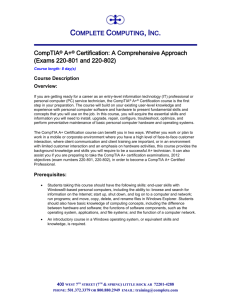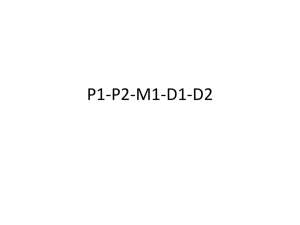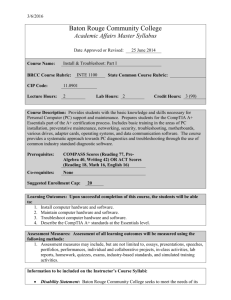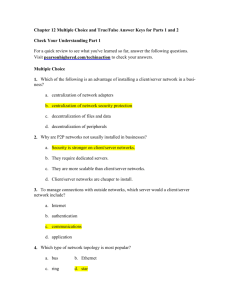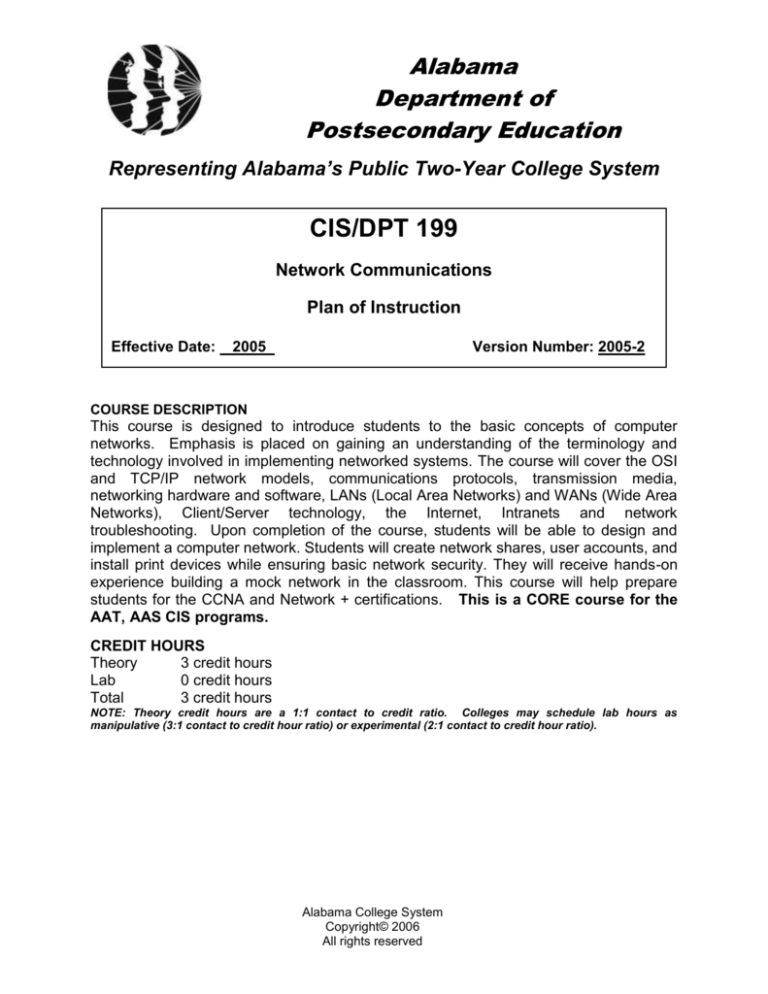
Alabama
Department of
Postsecondary Education
Representing Alabama’s Public Two-Year College System
CIS/DPT 199
Network Communications
Plan of Instruction
Effective Date:
2005
Version Number: 2005-2
COURSE DESCRIPTION
This course is designed to introduce students to the basic concepts of computer
networks. Emphasis is placed on gaining an understanding of the terminology and
technology involved in implementing networked systems. The course will cover the OSI
and TCP/IP network models, communications protocols, transmission media,
networking hardware and software, LANs (Local Area Networks) and WANs (Wide Area
Networks), Client/Server technology, the Internet, Intranets and network
troubleshooting. Upon completion of the course, students will be able to design and
implement a computer network. Students will create network shares, user accounts, and
install print devices while ensuring basic network security. They will receive hands-on
experience building a mock network in the classroom. This course will help prepare
students for the CCNA and Network + certifications. This is a CORE course for the
AAT, AAS CIS programs.
CREDIT HOURS
Theory
3 credit hours
Lab
0 credit hours
Total
3 credit hours
NOTE: Theory credit hours are a 1:1 contact to credit ratio. Colleges may schedule lab hours as
manipulative (3:1 contact to credit hour ratio) or experimental (2:1 contact to credit hour ratio).
Alabama College System
Copyright© 2006
All rights reserved
Network Communications
CIS 199
PREREQUISITE COURSES
Determined by college unless stated otherwise.
CO-REQUISITE COURSES
Determined by college unless stated otherwise.
INSTRUCTIONAL NOTE: Foundational academic skills in General Math such as
integers, percents, ratio and proportions, metric system and linear equations and
Technical Writing such as research, organization, composition, documentation, and
report presentation are used throughout this discipline.
PROFESSIONAL COMPETENCIES:
Install, configure, and troubleshoot network hardware
GENERAL INSTRUCTIONAL OBJECTIVES:
The cognitive objective for this course is for each student to comprehend foundational
knowledge of computer network systems.
The performance objective of this course is for each student to apply foundational
knowledge of computer network systems encountered in a classroom simulated
workplace environment.
PROFESSIONAL COMPETENCIES/OBJECTIVES
Unless otherwise indicated, evaluation of student’s attainment of cognitive and
performance objectives are based on knowledge gained from this course. During
performance evaluations, students will be provided necessary tools, equipment,
materials, specifications, and any other resources necessary to accomplish the task.
Specifications may be in the form of, but not limited to, manufacturer’s specifications,
technical orders, regulations, national and state codes, certification agencies, locally
developed lab assignments, or any combination of specifications
ACS Copyright© 2006
All rights reserved
2
Network Communications
CIS 199
MODULE A – NETWORKING PRINCIPLES
PROFESSIONAL COMPETENCIES
STUDENT PERFORMANCE OBJECTIVES
There are no psychomotor assessments associated with this module. Measurement of these
competencies must be through cognitive assessment of each enabling objective.
ENABLING OBJECTIVES
Define terms associated with networking
Explain the procedures for obtaining a network certification (Network +/CCNA)
Identify the components of a network
Explain the primary functions of an operating system
Explain Network standards
Explain device drivers and the OSI model
Explain Network protocols:
o IP
o TCP
o UDP
o NetBIOS,
o IPX/SPX
o RIP
o ARP
o ICMP
o SMTP
Explain network topologies
ACS Copyright© 2006
All rights reserved
3
Network Communications
CIS 199
MODULE B – INSTALLING AND TESTING NETWORK COMPONENTS
PROFESSIONAL COMPETENCIES
Install, configure, and troubleshoot
network hardware
STUDENT PERFORMANCE OBJECTIVES
Fabricate network cable
Assemble network support equipment
Install network hardware
Install wireless network components
Configure network hardware
Perform preventive maintenance on a network
Install, configure, and troubleshoot
network operating systems
Troubleshoot network hardware
Install a network operating system
Configure the network operating system
Install protocols for network security
Install and run network applications on a
PC LAN
Troubleshoot the network operating system
Install network applications on a PC LAN
Run network applications on a PC LAN
ENABLING OBJECTIVES
Identify the types of physical connectivity used for networking
Explain the process of certifying physical connectivity standards
Explain the use of tools used for installing network equipment and components
Explain the process of fabricating network cable
Summarize the process of installing and configuring network hardware
Identify components for wireless applications
Summarize the process for installing wireless components
Summarize the process of installing and configuring a network operating system
Summarize the process of installing and configuring network applications
Explain the process of troubleshooting a network using software and hardware tools
Explain the process of creating network shares and accounts
Explain the process of ensuring network security
Identify critical components to check while performing preventive maintenance
Explain the process of performing preventative maintenance
Explain when and how to upgrade network components, developing a baseline, recording
network performance and components
ACS Copyright© 2006
All rights reserved
4
Network Communications
CIS 199
COURSE CONTENT OUTLINE
MODULE A – NETWORKING PRINCIPLES
Networking terms and concepts
Network + and CCNA certification procedures
Network components
Network operating systems
Network standards
Network protocols
MODULE B – INSTALLING AND TESTING NETWORK COMPONENTS
Network hardware
Network operating systems
Network applications
ACS Copyright© 2006
All rights reserved
5
Network Communications
CIS 199
RECOMMENDED METHODS OF EVALUATION: The table of specifications below
identifies the number of enabling objectives/key indicators per cognitive domain level of
learning (Knowledge, Comprehension, Application) per module. Instructors should
develop a minimum of 1-3 test questions per Knowledge Level of Learning, 2-4 test
questions per Comprehension Level of Learning, and 5-6 questions per Application
Level Learning. Instructors should use the following test item types for each level of
learning:
Knowledge: Multiple Choice, Alternative Response test items (true/false or yes/no)
Comprehension: Multiple Choice, Short answer
Application: Multiple Choice, Short Answer Exercises
The table of specifications below also identifies the number of criterion objectives per
module. The instructor should ensure each student meets the performance and
standards published in each objective.
TABLE OF SPECIFICATIONS
Domain of
Cognitive Domain
Learning/
Knowledge
Comprehension
Application
Content
Module A
2
14
0
Module B
3
12
0
Number of
indicators
5
26
0
per level
ACS Copyright© 2006
All rights reserved
Total
Cognitive
Total
Performance
16
15
0
13
31
13
6



